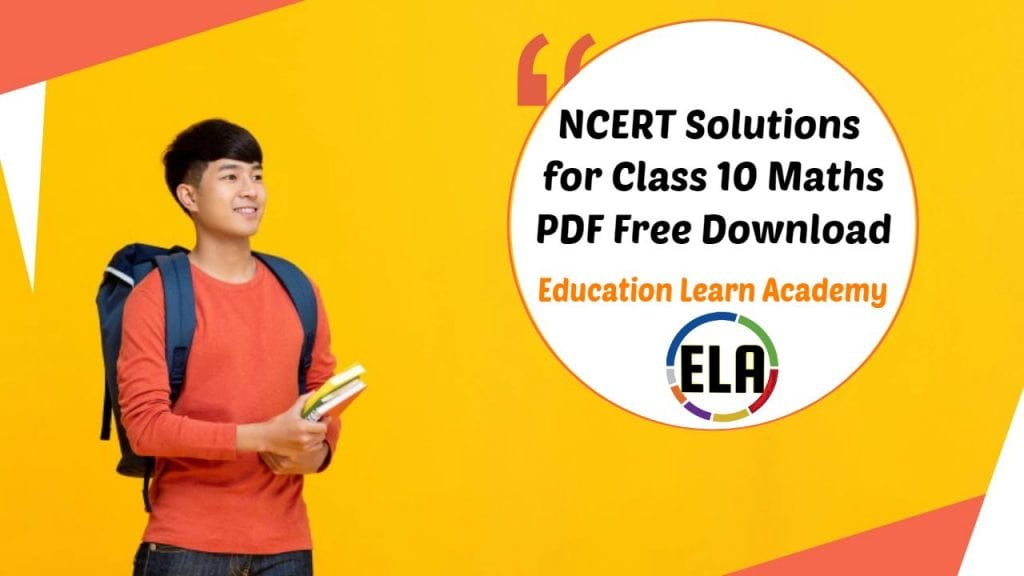NCERT Solutions for Class 10 Maths PDF: Discover NCERT Solutions for Class 10 Mathematics in both PDF and video formats. These resources are available in Hindi and English for the 2024 academic session, catering to students from CBSE, UP, Gujarat Board, MP Board, Bihar, Uttarakhand Board, Jammu and Kashmir Board of School Education (JKBOSE), and various other boards implementing the new CBSE Curriculum for 2024.
Access offline apps aligned with the updated NCERT solutions, in line with the most recent NCERT books for 2023. Gain free access to CBSE study materials for your exam preparations in PDF format. Furthermore, you can actively engage in our discussion forum to share your insights and seek answers to your educational queries.
NCERT Solutions For Class 10 Maths
| Class: | 10 |
| YEAR | 2024 |
| Category | Ncert Solutions |
| Subject: | Maths – गणित |
| Medium: | English – हिंदी |
NCERT Solutions for Class 10 Maths PDF Free Download Chapter-wise
Students can click on the subject wise links below. Refer to latest Mathematics NCERT Solutions for Class 10 below
Numerous schools all around India highly suggest the NCERT Class 10 Mathematics textbooks. These textbooks are a critical resource for students in the 10th grade since they provide thorough and understandable explanations of all mathematical concepts and themes.
In other words, these CBSE NCERT Mathematics ebooks are suggested for a variety of competitive exams in addition to being utilised in classrooms.
REAL NUMBERS CHAPTER 1: You’ll start your trip into the world of real numbers in the first chapter of Class 10 Mathematics. These numbers make for the fundamental building blocks of mathematics and the key to comprehending the world of numbers. Here, you’ll learn about the distinctive characteristics of real numbers, such as how they can be expressed in both rational and irrational ways. You’ll examine their decimal expansions, learn the amazing stories associated with square roots, and consider how useful the Euclidean technique is.
CHAPTER 2: POLYNOMIALS In this chapter, you will learn about the roots of polynomials, the connection between these roots and the coefficients of quadratic polynomials, and Euclid’s division lemma.
CHAPTER 3: LINEAR EQUATIONS IN TWO VARIABLES This chapter focuses on solving linear equations using four different methods: the graphical method, elimination method, substitution method, and cross multiplication method, all within the context of word problems.
CHAPTER 4: QUADRATIC EQUATIONS Here, you’ll get an insight into solving quadratic equations (if they have real roots) through techniques like factorization, completing the square, and using the quadratic formula.
CHAPTER 5: ARITHMETIC PROGRESSIONS Arithmetic Progressions (AP) involves understanding the nth term, sum of the first n terms, and their practical applications in solving real-life problems.
CHAPTER 6: TRIANGLES This chapter covers the definitions and examples of similar triangles, proofs of theorems (Basic Proportionality Theorem-BPT/Thales, Pythagoras, Similar triangle), and questions based on these theorems.
CHAPTER 7: COORDINATE GEOMETRY Coordinate Geometry introduces the Distance formula and explores questions related to the equality of sides in triangles, types of quadrilaterals, section formulas, and the area of triangles.
CHAPTER 8: INTRODUCTION TO TRIGONOMETRY In this chapter, you’ll learn about trigonometric identities used to find missing angles and sides of triangles. Important identities are proven through right triangles and basic identities.
CHAPTER 9: SOME APPLICATIONS OF TRIGONOMETRY This chapter delves into the practical applications of trigonometry in daily life, which is a new and important topic for class 10 students.
CHAPTER 10: CIRCLES The Circles chapter discusses tangents to circles at the point of contact. Two theorems are presented for proof: Theorem 1 states that the tangent at any point on a circle is perpendicular to the radius at that point, and Theorem 2 asserts that the lengths of tangents drawn from an external point to a circle are equal.
CHAPTER 11: CONSTRUCTIONS Constructions teach you how to divide a line segment into a given ratio, draw tangents to a circle from a point outside it, and construct a triangle similar to a given one. Step-by-step construction procedures are provided for easy understanding.
CHAPTER 12: AREAS RELATED TO CIRCLES In this chapter, you’ll learn how to calculate the areas of sectors, segments, and the area and perimeter of plane figures (triangles, simple quadrilaterals, and circles). Questions related to sectors or segments are restricted to central angles of 60, 90, 120 degrees, etc., suitable for class 10 students.
CHAPTER 13: SURFACE AREAS AND VOLUMES Surface Areas and Volumes involve calculating the surface areas and volumes of combinations of two or three-dimensional shapes such as cubes, cuboids, spheres, hemispheres, cones, cylinders, and frustums of cones. This chapter explores how to convert one shape into another using volume concepts.
CHAPTER 14: STATISTICS The Statistics chapter covers the general methods for finding mean, mode, median, cumulative frequency graphs, and the relationships between the three measures of central tendency (3 Median = 2 Mean + Mode).
CHAPTER 15: PROBABILITY Probability introduces the classical definition of probability and addresses problems related to single events only.
For each chapter, there are assignments, practice worksheets, chapter-wise test papers with varying difficulty levels, solved assignments, and full-length practice papers with answers and solutions for the current academic year in 2024. Solutions for Hindi subjects are also available, prepared and revised by experts as needed.

CBSE NCERT Solutions For Class 10 Maths
NCERT – CBSE Solutions for class 10 Maths all chapters are given below updated for new academic session 2024. You may download to use it offline or use online as it is. Download 10 Maths App in Hindi or 10 Maths in English for offline free.
NOTE (Disclaimer): This Post May Potentially Match Another Post On The Internet As It Has Been Sourced From An Ncert Book. However, The Content Inside The Post, Including The Pdf Solution, Is My Original Work. Therefore, There Is A Possibility Of Up To 50% Similarity With Other Sources. But I Will Provide A Direct Pdf Link, Which Is Unique To My Website Across The Internet. Nevertheless, It’s Important To Emphasize The Sharing Of Knowledge Rather Than Just The Content Itself, As Finding Solutions Independently Is Vital, Regardless Of The Post’s Originality. This Post Appears To Have Been Excerpted From An Ncert Book Solution.
NCERT Solution for Class 10
Guide as well as solutions of NCERT Textbooks for Class 10 Maths, Science, Social Science and Hindi are given below to download in PDF based on Latest and updated NCERT Books.
What is meant by degree of a polynomial?
If p(x) is a polynomial in x, the highest power of x in p(x) is called the degree of the polynomial p(x).
The larger of two supplementary angles exceeds the smaller by 18 degrees. Find them.
Let the larger angle = x
Let the smaller angle = y
According to question,
x = y + 18 … (1)
Both angles are supplementary, therefore
x + y = 180 … (2)
Putting the value of x in equation (2), we get
y + 18 + y = 180
⇒ 2y = 162
⇒ y = 81
Putting the value of y in equation (1), we get
x = 81 + 18 = 99
Hence, one angle is 81° and the other one is 99°.
3825 को अभाज्य गुणनखंडो के गुणनफल के रूप में व्यक्त कीजिए।
3825
= 3×3×5×5×17
In a class test, the sum of Shefali’s marks in Mathematics and English is 30. Had she got 2 marks more in Mathematics and 3 marks less in English, the product of their marks would
Let, Shefali’s marks in Mathematics = x
Therefore, Shefali’s marks in English = 30 – x
If she got 2 marks more in Mathematics and 3 marks less in English,
Marks in Mathematics = x + 2
Marks in English = 30 – x – 3
According to questions, Product
= (x + 2)(27 – x) = 210
⇒ 27x – x^2 + 54 – 2x = 210
⇒〖-x〗^2 + 25x – 156 = 0
⇒ x^2 – 25x + 156 = 0
⇒ x^2 – 12x – 13x + 156 = 0
⇒ x(x – 12) – 13(x – 12) = 0
⇒ (x – 12)(x – 13) = 0
⇒ (x – 12) = 0 or (x – 13) = 0
Either x = 12 or x = 13
If x = 12
then, marks in Maths = 12 and marks in English = 30 – 12 = 18
If x=13
then, marks in Maths = 13 and marks in English = 30 – 13 = 17
Write first four terms of the AP, when the first term a and the common difference d are given as follows: a = 10, d = 10.
a = 10, d = 10
First term a_1 = a = 10
Second term a_2 = a_1 + d = 10 + 10 = 20
Third term a_3 = a_2 + d = 20 + 10 = 30
Fourth term a_4 = a_3 + d = 30 + 10 = 40
A ladder 10 m long reaches a window 8 m above the ground. Find the distance of the foot of the ladder from base of the wall.
Let OA is wall and AB is ladder.
In ∆AOB, by Pythagoras theorem
AB^2 = OA^2 + OB^2
⇒〖10〗^2 =8^2 + BO^2
⇒ 100 = 64 + BO^2
⇒ BO^2 = 36
⇒ BO = 6 m
Hence, the distance of the foot of the ladder from the base of the wall is 6 m.
In∆PQR, right-angled at Q, PR + QR = 25 cm and PQ = 5 cm. Determine the values of sin (P), cos〖P〗 and tan〖P〗
Given that: in ∆PQR, angle Q is right angled.
Let QR = x, therefore, PR = 25 – x
In ∆PQR, by Pythagoras theorem, we have
〖PR〗^2= 〖PQ〗^2 + 〖OQ〗^2
⇒ (25 – x)^2 = (5)^2 + 〖(x)〗^2
⇒ 625 + x^2 – 50x = 25 + x^2
⇒ 625 – 50x = 25
⇒ 50x = 600
⇒ x = 12
⇒ QR = 12
Therefore,
PR = 25 – 12 = 13
Now,
sin(P) = QR/PR = 12/13,
cos(P) = PQ/PR = 5/13
tan(P) = QR/PQ = 12/5
How can we find the height of an object without measuring?
The height or length of an object or the distance between two distant objects can be determined with the help of trigonometric ratios.
Prove that the tangents drawn at the ends of a diameter of a circle are parallel.
Let AB is diameter, PQ and RS are tangents drawn at ends of diameter.
We know that the radius is perpendicular to tangent. Therefore, OA ⊥ RS and OB ⊥ PQ.
∠OAR = 90° and ∠OAS = 90°
∠OBP = 90° and ∠OBQ = 90°
From the above, we have
∠OAR = ∠OBQ [Alternate angles]
∠OAS = ∠OBP [Alternate angles]
Since, alternate angles are equal.
Hence, PQ is parallel to PS.
Tick the correct answer in the following and justify your choice: If the perimeter and the area of a circle are numerically equal, then the radius of the circle is (A) 2 units (B) π units (C) 4
Let the radius of circle = r, Circumference of circle (perimeter) = 2πr, Area of circle = πr2
Given that the perimeter and area are equal in magnitude. Therefore
2πr = πr2
⇒ 2 = r
Therefore, the radius of circle is 2 units.
Hence, the option (A) is correct.

Like!! I blog frequently and I really thank you for your content. The article has truly peaked my interest.